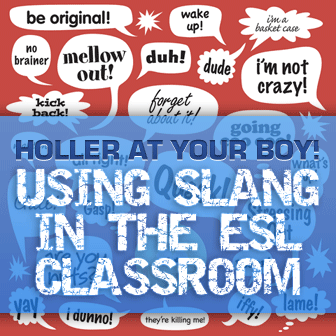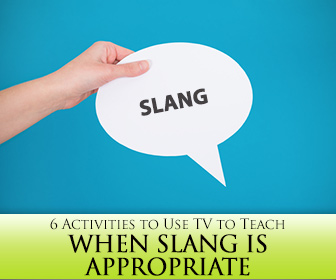Holler at Your Boy! Using Slang in the ESL Classroom


In fact, we unconsciously hone slang depending on the cultural situation in which we are. Demonstrating those situations through TV can be particularly helpful in your ESL/EFL conversation course, especially when students are trying to reach a more fluent conversational level. The following are six activities that use TV to teach EFL students when certain slang is not only acceptable, but appropriate.

To be accepted in a social group, we need to be cool, and, to be cooler, we incorporate slang modifiers into conversation. Teenagers might use more slang modifiers than educated adults, but educated adults do use them as well, especially in relating to their teen offspring. Cool, awesome, and all of their slang modifier cousins are important words to incorporate into the EFL student’s vocabulary. Use any of a number of teen TV shows and pick a scene heavy in “cool” and “uncool” speak. Glee is a perfect choice. Prepare a list of slang words students will hear and ask them to mark which words/phrases are “cool” and which mean “uncool”. Discuss the right answers.
We use slang when we are comforting someone confiding in us about something negative that happened to her, or something about which she is scared or worried. We break out clichés and colloquial speech as a familiarity cultural tool to help soothe. TV is full of emotionally dramatic situations between confidantes; nearly any prime time sitcom or drama has at least one scene per episode of people in crisis. Pick a moment between friends or relatives, preferably women as they receive more emotional dialogue time. Use a dialogue between Lily and Robin in How I Met Your Mother, for example. This activity will work better if it is a short three minute clip that you can show a few times. Find the transcript. Blank out the confiding/comfort slang, and ask students to try to fill in the words they hear as you play the clip. Play it twice. Then, go over what the phrases were and what they mean in formal English.
EFL learners need to understand slang to express surprise. Conversation with natives will be impossible to comprehend otherwise. Pick a TV clip where an actor is revealing a crazy event to a group and they react. Nearly any coffeehouse scene from Friends where all six are together works. Have students write the surprise expressions they heard on the board, and then brainstorm additional expressions they know or have heard in other places as well. Afterwards, have them practice using expressions in conversation. Ask each student to tell a partner the craziest thing that happened to him the week before. His partner should react with a surprise idiom, like “Wow, that’s crazy!” They should write down the conversation, switch roles, and repeat.
Generally, maintaining formality at the office is a good rule of thumb. If your EFL learners do so all the time, however, they will have no friends, confidantes, or allies. Every workplace thrives on comic relief periodically throughout the day with people gossiping or telling stories. Those are the moments when people use slang in the workplace. Teach your students to identify informal moments and appropriately react to them by listening for slang. Show a TV clip from The Office (almost any) that has two scenes contrasting formal and informal language, Angela with Dwight and then with Michael, for example. Doctor shows are good for this as well, to contrast how doctors talk to patients and then to colleagues in the break room. Ask students in a discussion afterwards which slang words indicate an informal break.
Slang greetings have varying levels of formality, and it is important to know what the formality level is to respond appropriately. Show any TV clip where people are greeting each other. A party scene with different social levels of people is probably a more helpful tool than a work setting. Use the clip as a launching point to discuss different greeting language. Write as many greetings as they can think of, from the clip and from their encounters with English from other places, on the board. Ask students to rate each based on a formality meter of one to five, one being informal and five being formal. Then, ask them one by one to respond to the greetings. If you ask “What up?” they should reply “Not much” instead of “I am well” or a more formal response.
Romance and sexual language is full of slang and can make an extremely fun conversation class! Keep it light by showing a dialogue clip from a PG TV show, one with teenagers talking about crushes or young love is ideal. Charlie explaining relationships to his nephew in Two and a Half Men would work. Students should pick out how slang is used to talk about romance. Then, separate the class into two groups and ask the students to form two lines. Throw out different slang romance terms, like “I dig her” and “she’s tripping”. The groups should take turns guessing how to translate the terms to plain English.
Students will dig these exercises!